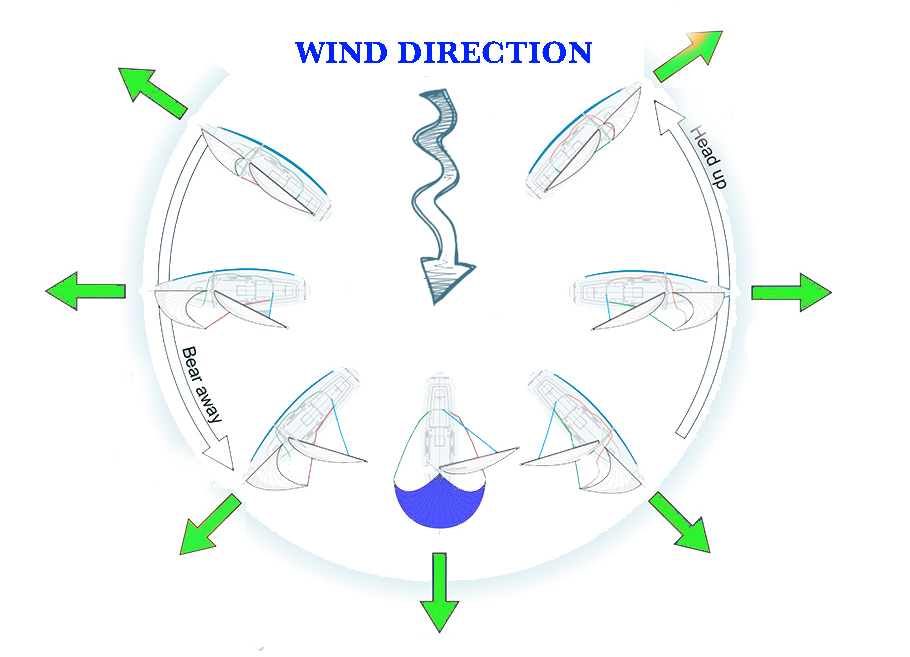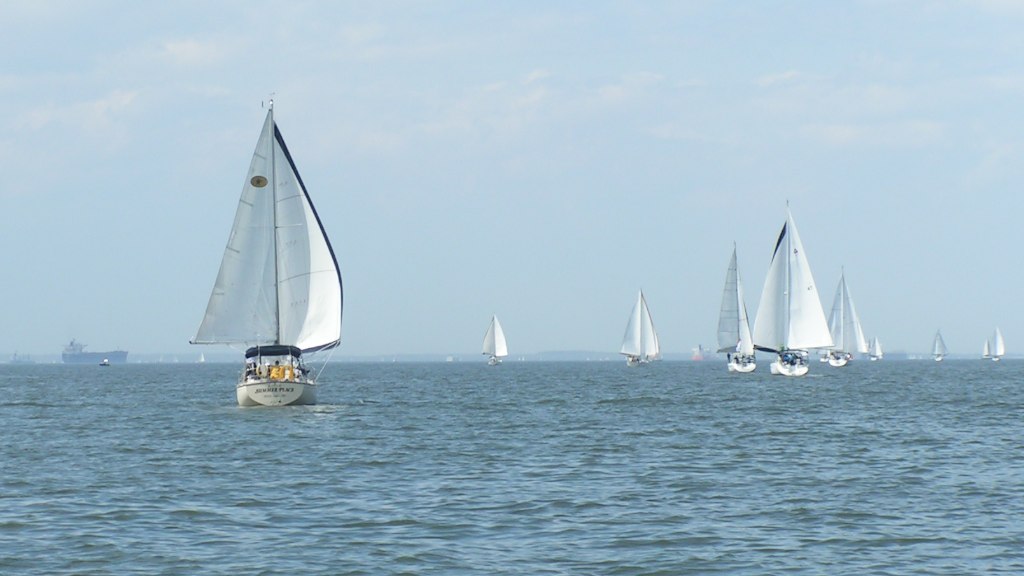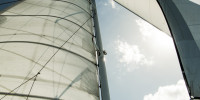15 Actionable Tips to Trim Your Sails for Speed
Trimming sails correctly will make an incredible difference to your speed. This article will teach you how to trim your sails right and get the most out of your boat. Regardless of whether you are on a Wally or an inflatable dinghy with an open umbrella (trust me, the latter works).
Here go a few great tips how to add those precious knots to your sailing speed.
Tips for wind from the front:
- Pay attention to telltales
- Deep sail draft for acceleration, shallow draft for speed
- Put jib car forward in lighter winds and backward in stronger winds to keep the sail tight
- Make marks on the jib sheet to have a quick point of reference
- Have your foresail and mainsail trimmed for the same purpose
Tips for wind from the back:
- You aren't generating lift, so maximize sail area
- During dead runs, use the goosewings (butterfly) formation
- Use spinnaker pole on the genoa
- Wind in your back is less effective, consider going circa 30 degrees off course
- Avoid spilling power from the sail
- Use spinnaker, if you can
Tips for wind from the side:
- Side winds tend to be the fastest course
- Tighten the vang so that the sail doesn't spill power
- Let the vang go a bit if overpowered
- Increase the space between mainsail and foresail
Once you know how to trim your sails well, you will have mastered one of the key aspects of sailing. Let's have a look at these points in more detail.

You see, it isn't all that difficult to set up the sails so that the boat somehow moves. But the correct trim will transport you from the realm of sailing fans, to the realm of sailors. One small change in the sail twist can boost your speed up a whole knot. And knowing how to do that, that's something to be proud of.
First of all, here is a little overview of how to position your sails for various wind directions. This is called 'points of sail'. Try to memorize this, as it is very basic knowledge. If you are a beginner, there is no shame in having these printed out and referring to them when sailing, until it becomes automatic.

Once you know your points of sail by heart, you are able to make the boat move wherever you want - but not necessarily at the highest speed.
So this article will go into more detail than this brief overview, it is about the more precise fine-tuning of the sails, to make sure you are getting the most out of whatever it is you are sailing on.
Tips for Sailing with Wind from the Front
This is also called 'close reach' or 'going upwind'.
1. Pay attention to telltales
These are the little colorful strings on your sails. Although this tip might seem obvious, I have seen way too many sailors who just go by the picture above and pay attention to little else.
Which is fine, don't get me wrong. It gets you from A to B. And after all, as long as you're having fun, who am I to rain on your parade. But if you want to go faster, especially if you are using sails to generate lift, the airflow around the sheets is a vital thing for you to see. And since air tends to be invisible, telltales are your best friend in seeing what is going on.

2. Deep draft for acceleration, shallow draft for speed
If you imagine a sail from the bottom, (meaning you are lying on your deck, staring up) the curve in which the sail is bent is called draft. So a very tight, almost flat sail will have a very low draft and a sail that is let go and inflated like a balloon has a very high draft.
The draft can be thought of as gears in your car. If you want to accelerate quickly, say you want to pull yourself from a tack, let the sail go slightly to increase the draft.
But see this as a lower gear. Thus once you reach a certain speed, you might want to pull the sail in, making it tighter and flatter, thereby decreasing the draft.
You see what I meant about fine-tuning? The sail would work fine even if you knew nothing about draft. You would still get where you wanted to go. But if you are in a race, or if it is getting dark and the anchoring bay is still far, it pays off to have a few tricks up your sleeve.
3. Put jib car forward in lighter winds and backward in stronger winds to keep the sail tight
Jib car is the moveable point on a rail that holds the corner of your foresail in place. You can choose to pull it closer to yourself or have it further up. This will dramatically change the shape of your sail.
Why do this? Thing is, the most effective shape of a sail doesn't depend just on wind direction, but also on the wind speed. Thus if the wind is more of a breeze than wind, you want your foresail to be slightly more bent. Slower wind just can't work well with a sail that is too tight, to generate lift. This is easily achieved by moving the jib car forward (further from the helm).
On the other hand, once the winds get faster, you want to pull the jib car backwards, making the foresail tighter.
Don't ask me about the physics of this. Someday I might write a very long and boring article full of numbers and curves and diagrams that will explain why these tips work the way they do. But for now, out of respect for those who don't particularly enjoy this sort of content, (such as myself) I will keep it digestible. Knowledge of physics behind sailing does help a bit, but so does experience.
4. Make marks on the jib sheet to have a quick point of reference
This is a relatively minor tip but it does save time (and thus speed) when tacking for instance.
Contrary to its name, a jib sheet is not a sheet but a rope. It is the rope tied to the bottom corner of your foresail, one that you winch in when tacking.
I sometimes mark a position on the jib sheet so that when tacking, I can just winch the sail into a specific, predetermined point without checking the sail and adjusting the ropes accordingly. It saves a bit of valuable time, which you need, because you want your tacking maneuvers to be as fast as possible. Especially if sailing single-handed.
5. Have your foresail and mainsail trimmed for the same purpose
Look around on the other boats while sailing. Especially in areas where you can expect a higher concentration of beginners, (I'm looking at you, Croatia) you oftentimes see boats where the two sails have drastically different settings. For instance one is trimmed for speed, the other one for acceleration (as described in point 2.). Or the sails are influencing each other's air flow negatively.
So make sure all of your sails are trimmed for the same purpose. You will rob yourself of valuable knots if the sails are fighting each other. What you want to achieve is the maximum amount of synergy. Two sails set for the same purpose can together produce a higher force than each of them would individually, combined. Take advantage of that.
Sail Trim Tips for Wind from the Back
This is also called 'broad reach', or 'dead run'.
6. You aren't generating lift, so maximize sail area
It is good to know whether you are using the sails to pull your boat or to push it at any given moment. While sailing with the wind in your back, there is no lift generated, so the only thing you need to pay attention to is maximizing the sail area exposed to wind.
This is relatively easy to do as it is intuitive. Think of your umbrella being taken away by the wind as it slipped from your fingers and now is headed away, never to be seen again :(
7. During dead runs, use the goosewings (butterfly) formation

Dead run means having the wind exactly in your back. If that is the case, use what is sometimes called goosewings or butterfly. This means you open your mainsail on one side and your foresail on the other side so that they don't block each other and the sail area is maximized. It isn't the fastest way to travel, but if that is your course and you don't have a spinnaker, this is what you have to work with.
8. Use spinnaker pole on the genoa
If you are flying goosewings, your mainsail easily holds shape as it is held by the mast from the side and the boom from the bottom. But what about the foresail?
If the wind is strong enough, the foresail will hold shape too. But more often than not, you might want to use your spinnaker pole to keep it open. Simply attach the pole to the foresail's bottom corner from one side and to the mast from the other side.
When using the spinnaker pole like this, secure it in place. If let to its own devices, it has the tendency to swing around, which can be fatal to whoever stands in its way.
Fun fact, your boat hook can do a good job at this too. I know, I know, all the pro sailors are now booing me and throwing rotten tomatoes at my head. But especially if you rent a cruiser, there very likely won't be a spinnaker pole on your boat. So you gotta work with what you've got.
9. Wind in your back is less effective, consider going cca 30 degrees off course
As hinted before, having wind in your back is not a very efficient way to travel. There are plenty of reasons for this, some being that the boat is not that easy to steer, meaning the wind course relative to your boat changes slightly, making the sail trim less effective, the boat tends to roll…
So many sailors prefer to go about 30 degrees off course, which is so much faster that it will most likely compensate for the fact that you won't be going directly to your destination.
10. Avoid spilling power from the sail
Spilling power means exactly what it sounds like - the wind 'spilling' out of the sail thus wasting the power. This tends to happen for instance if the foresail is eased quite a bit, as it tends to 'open' in its top part.
This might happen when you open the sail to maximize the sail area exposed to the backwind, but if you overdo it, the sail might open too much, especially at the top, spilling the power.
11. Use spinnaker, if you can

The frustration with the inefficiency of the rear winds led to the development of spinnakers. These are sort of balloon-shaped sails that cover a lot of area and thus are used when the wind blows from behind. Before you do use one though, consider reading up on it a bit. Spinnakers aren't that forgiving to mistakes and have the power to flip a boat if the conditions are 'right'.
If you want to learn more about all the different sail types, we have an excellent illustrated guide with examples on just that. You can read it here.
Sail Trim Tips for Wind from the Side
This is also called 'beam reach'.
12. Side winds tend to be the fastest course...
...because the power of pushing and pulling (lift) are combined. So although this article is about trimming sails for speed, I can't but mention that sometimes it pays off to sacrifice sailing directly towards your destination as the gained speed can make up for it. This is especially true with side winds.
When planning your route, keep this in mind. Just as I mentioned above that sacrificing the 30 degrees when the wind is in your back might pay off, the same goes for this So rather than trying to trim the sails as well as you can, while maintaining a direct course, consider if it wouldn't pay off to instead change your heading.
13. Tighten the vang so that the sail doesn't spill power
With sailing on a beam reach, it is easy to spill power from your mainsail unnecessarily. Pay attention to it and if this happens, tighten the vang, making the sail a bit flatter.
When sailing on this particular course, the top of your jib will almost inevitably spill some wind. Consider that a necessary sacrifice and use the vang or pull the sail in to make sure the middle part doesn't start spilling as well.
Sadly, many sailboat manufacturers choose not to install the vang. You might play around with the available ropes to try to pull the boom downwards a bit to compensate, but since a vang is a vang, try to make sure your boat of choice has this installed when buying or renting.
14. Let the vang go a bit if overpowered
With winds from the side, you might easily encounter excessive healing of your boat. An easy fix (to an extent) is to do exactly the opposite of what the previous point suggested and loosen the vang slightly. As the wind spills, the force exerted on the sails will be reduced and your boat will return to a more comfortable position.
There are of course more ways as for instance reducing the sail area, but playing around with vang is one of the fastest and most readily available ones.
15. Increase the space between mainsail and foresail
Since this list began with the telltales, let's end with them as well.
With side winds, both your mainsail and foresail will be on one side. And since you will likely let the mainsail out quite a bit, the space between the two sails will tend to get smaller.
As a result, the sails might negatively influence the airflow around each other, which is something the telltales will show you. You don't want this to happen, so if it does, open up genoa slightly to increase the space. The telltales will be the best way to know you are doing a good job.
Conclusion
So that's it. There are of course plenty of other tips and tricks, but these fifteen are among those I used the most frequently while sailing.
The best way to get them under your skin is to go out and practice. These particular tips are best tried out with a speedometer, so watch the numbers closely and test out for yourself how these steps influence your speed.
Related Questions:
Is there a video guide? Yes. And frankly, when it comes to sail trim, it often helps to see things on video or a picture. If you google this topic, you will find plenty of video sailing schools so check them out.
Can I test this on a simulator? Definitely. Not all will agree with me, but I think sailing simulators such as Sailaway are a great way to practice. The real thing is the real thing, but since you can't snap your fingers and appear on a boat anytime you wish, this is the next best thing.
Did you find the answer to your specific question?
👍 15 👎 0



Comments
Robert Johnson
Very informative. I have been sailing my 23.2 O’Day for the last 6 years with great joy. I have been applying the 15 steps you mentioned with out really knowing what they where. This clarified what I was doing and will help me pay more attention to the effects. Last summer I had the boat out 95 times, although not always under sail. Thanks for the info, can’t wait to get out there again. Last summer I even managed to keep up with my son-in-law’s Laser in a stiff breeze.
Leave a comment